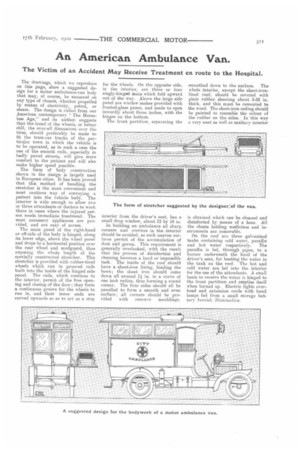An American Ambulance Van.
Page 19

If you've noticed an error in this article please click here to report it so we can fix it.
The Victim of an Accident May Receive Treatment en route to the Hospital.
The drawings, which w e reproduce on this page, show a suggested design for a motor ambulance-van body that may, of course, be mounted on any type of chassis, whether propelled by means of electricity, petrol, or steam. The design is culled from our American contemporary "The Horseless Age," and its author. suggests that the tread of the wheels, or better still, the over-all dimensions over the tires, should preferably be made to fit the tram-car tracks of the particular town in which the vehicle is to be operated, as in such a case the use of the smooth rails, especially in badly paved streets, will give more comfort to the patient and will also make higher speed possible. The form of body construction shown in the design is largely used in European cities. It has been proved that this method of handling the stretcher is the most convenient and most cautious way of conveying a patient into the vehicle body. The interior is wide enough to allow two or three attendants or doctors to work there in cases where the injured person needs immediate treatment. The most necessary appliances are provided, and are easy of access.
The main panel of the right-hand or off-side of the body is hinged, along its lower edge, above the wheel panel and drops to a horizontal position over the rear wheel and mudguard, thus exposing the whole length of the specially constructed stretcher. This stretcher is provided with rubber-tired wheels which run in grooved rails built into the inside of the hinged side panel. The rails, which continue to the interior, permit of the free opening and closing of the door ; they form a continuous groove for the wheels to run in, and their inner ends are curved upwards so as to act as a stop
for the wheels. On the opposite side, in the interior, are three or four singly-hinged seats which fold upward out of the way. Above the large side panel are window sashes provided with frosted-glass panes, and made to open inwardly about three inches, with the hinges on the bottom.
The front partition, separating the interior from the driver's seat, has a small drop window, about 12 by 18 in.
In building an ambulance all sharp corners and crevices in the interior should be avoided, as such uneven surfaces permit of the accumulation of dust and germs. This requirement is generally overlooked, with the result that the process of disinfection and cleaning becomes a hard or impossible task. The inside of the roof should have a sheet-iron lining, binding the bows; the sheet iron should come down all around 1 in. in a curve of one inch radius, thus forming a round corner. The four sides should all be panelled to form a smooth and even surface; all corners should be provided with concave mouldings.
smoothed down to the surface. The whole interior, except the sheet-ironlined roof, should be covered with plain rubber sheeting about 3-32 in. thick, and this must be cemented to the wood. The sheet-iron ceiling should be painted to resemble the colour of the rubber on the sides. In this way a very neat as well as sanitary interior
is obtained which can be cleaned and disinfected by means of a hose. All the chests holding medicines and instruments are removable.
On the roof are three galvanized tanks containing cold water, paraffin and hot water respectively. The paraffin is led, through pipes, to a burner underneath the hood of the driver's seat, for heating the water in the tank on the roof. The hot and cold water are led into the interior for the use of the attendants. A small basin to receive the water is hinged to the front partition and empties itself when turned up. Electric lights overhead and extension cords with hand lamps fed from a small storage battery furnish
























